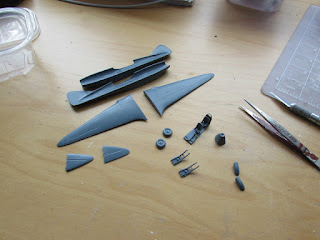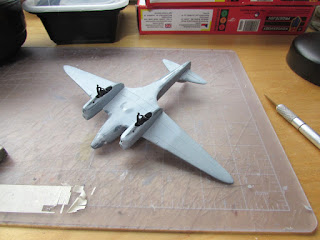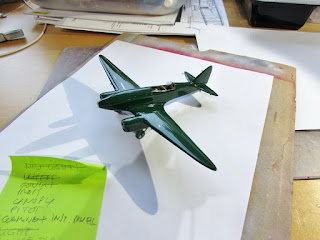I will just add that because of my unquenchable love for
this plane I have built a number of DH88s, from Airfix ancestry and from the
beautiful and exquisite resin cast offered also in 1/72 by the Hungarian firm S.B.S.
Model.
Still undeterred, I bought the recently released boxing from
KP, a manufacturer that has been lately releasing some beautiful kits, the
civil Avia B.H.11 among them
Encouraged by those releases I embrace now the build of this
DH88, an injected rendition of the iconic machine.
I have to say, before starting, that the SBS kit is a
formidable one, and I don't believe that any injected kit could beat it, but
the idea is perhaps to have an affordable, easier to build endeavor for those
that still tremble and shake at the mere sight of a resin kit.
Fear not, this KP rendition is in some ways well above the
old and venerable Airfix kit, being a much modern kit, but I am sure connoisseurs
will soon find areas that may leave a bit to be desired, as is seemingly the
fate of all things produced by humans, including little humans themselves.
Here are some shots of the contents, for your perusing and
amusement:
Here is the completed model:
https://wingsofintent.blogspot.com/2019/01/de-havilland-dh88-comet-kp-172-completed.html
Here is the completed model:
https://wingsofintent.blogspot.com/2019/01/de-havilland-dh88-comet-kp-172-completed.html
Now, this is a short run kit, meaning that instead of using the known techniques of gluing the parts together right on, aka "assembling", you may need to utilize an arcane technique, nowadays almost in disuse, called "modeling". These pips, for example, will need careful removing:
Due to the nature of the molding process (and some questionable master-making) some parts will present small dimples that will need filling:
The detail is good overall:
There is a reasonable degree of surface detail:
More dimples:
And the culprit as usual is a master for the part that is not properly hollowed, rendering a too thick area that contracts on cooling. If the spinner and pointy nose would have been a hollow shell, no dimples would have been present. Instead, the master maker produced solid parts that in turn provoked the defect. Nothing to tear your vest and cry, though. The detail on the spinners, otherwise good, will no doubt suffer. I clarify that the dimples are NOT the ones molded for the prop blades, which are located on a different position:
I sanded the main parts flat, without exaggerating, which will produce a bad fit down the lane, so be careful and restrained:
Short run technology, small, thin and fragile parts, and thick sprue gates don't get along well.
Long ago I learned that this rod-like parts are better cut from stretched sprue than try to extricate them and clean them, wasting time and energy:
The cockpit pan is assembled and wing and wheel halves are glued together.There are very small (and again fragile) additional structural parts to glue to the landing gear legs. Perhaps they were not molded as the ones already present there to allow for the legs to spread and accept the wheels. Whatever the case, they are too wide and need careful trimming and gluing.
Most parts are rendered thicker than one would wish, but hey, short run, affordable kit. What can you do (besides trying to thin walls and such). I have the impression that the wings and horizontal stabilizer (and vertical stabilizer) are again thicker than what this scale calls for. May be it's subjective.
The nose tip clear part is present in the same sprue that holds the canopy, but absent from the instructions and parts's map.
The Ratier prop logo is present on the decal sheet, but not really accurate.
In any case we have a decent kit of a nice, important plane, with some reasonable detail, for a reasonable price. One can't have it all:
The locating recesses on the stabs roots are drilled through. The landing gear braces are replaced with parts made of rod stock:
Some additional notes I am jotting down as the build progresses:
-The nose tip clear part is present in the same sprue that holds the canopy, but absent from the instructions and parts's map.
-The Ratier prop logo is present on the decal sheet, but not really accurate.
-The landing gear parts that attach to the legs coming from the back at the well should have an horizontal connecting bit, absent from the kit, and are somewhat inaccurate (look at photos of the real thing).
-The interior depicted is not accurate for all the three planes you can build with this kit, so again check references. There are variations depending on the specific plane and at different times on their lives.
-The engineering of the engine gondolas will prevent the modeler from dealing comfortably with the different colors of the elements of the landing gear, wheel well, wheel and the gondola itself.
-The wings are a butt joint with the fuselage (but not the stabs, which have pips, go figure), so it is highly advisable to procure some means of securing them (metal pins, plastic rods, etc).
-As with other DH88 models, you have to take care of the flaps underneath the fuselage, which run from the wing to the center line, and fill any seams that may disrupt their contour.
-If you butt join the wings with the angle they have built in, you may end up with excess dihedral, so check that up.
-There is no provision or any indication for the prominent Pitot that goes on the right wing L.E.
A base color is applied to the fuselage interior and the cockpit pan>
Detailing of the interior ensues, adding a couple etched parts, some little extras, and some color notes:
The cockpit pan should rest on the right fuselage side where the locating devices for it are:The inst. panel and the radio (which I will not likely use) are given a base color, and the additional members added to the landing gear:
The somewhat inaccurate canopy of this kit is due to the over-simplification of it shape:
The front is angular and drops not far from the vertical, whilst the back is curved and drops in a much wider angle. This is not reflected on the kit's part, which has a somewhat constant section, giving that squatty impression:
Seeing that the landing gear main assembly can be slid-in from above the engine gondola, I decided to join its halves, but before I added a generic cylinder behind the air scoop, and drilled a small circular intake prominently seen in photos too. I find it sad that KP did not provide for this front cylinder to avoid the see-through effect so conspicuous in lesser kit. Easily fixed, though.
I am also sad to report that once you joined the halves they do not correctly match the shape molded under the wing where they go. We'll see if a spread bar later on helps with that issue:
So, where were we...A general view. The coaming and inst. panel are painted and glued together, waiting to be put in place after the fuselage seams are dealt with. As you can see those seams needed some amount of putty, whatever the case may be, because of my bad modeling manners or the kit demanded so.
The peduncle at the attachment point of the blades to the sprue is sanded thin to be later inserted in previously drilled locating holes in the spinners. As I mentioned, all my four spinners had small sink holes, and since I plan to model the variant with the ones that have the "circumcision", those will be not easy to fix or hide. We'll see.
Holes and pegs are fashioned to secure the otherwise butt-joined wings:
All flying surfaces in place.
The fit is not prefect (the Karman roots on the fuselage sides are slightly larger than the wing roots, and a hair that way also for the stabs), but all these can be smoothed, and it is usually part of these short run endeavors. Hey, put those skills at work.
Application of a dab of putty to erase the flaps seam at their midspan produced by the parts break-up.
The landing gear continues to be detailed according to references. Is this throwing good money after bad (meaning detailing things whilst the general demeanor of the kit does not reach that level)? well the kit is not a jewel of precision, but some details may enhance a bit the general looks:
The not so brilliant fit of the engine gondolas decided me to deal first with the seams and surface of the main body, including priming, and then once all that area is fine to proceed with the gondolas, one at a time. As you can see, whatever this is caused by my building or the parts, the seams need some fixing:
A session with the airbrush is being prepared for the multiple builds:
There are some issues with the front of the engine nacelles.
I drilled a spot for an intake tube visible in photos:
And instead of using the part provided by the kit (small and very difficult to clean) I drilled another hole for a pipe:
The engine front is rather blunt, whilst the real thing is more curvaceous, a fact readily noticeable on the air intake which looks rather poor. I contoured the front a bit to approximate it more to reality:
The front tube intake (brass tube) and the exhaust (drilled plastic rod) are now prepared:
Primer is applied and the landing gear is painted black in preparation:
This is for me the most fastidious stage: priming, sanding, puttying, sanding, oh the inexhaustible layers, akin to political coverup. Darn!
Landing gear glued inside nacelles, and nacelles glued on the wing. The fit is somewhat vague and indifferent, lacking locating devices and being the nacelles slightly different in shape than their seat on the wing:
The aftermarket masks arrived:
The poor noble beast looks awful at this stage, but it's ready for some paint now:
While considering the short-run nature of these molds, where a modicum of skills is required, one can deal easily with most minor challenges presented during the build, but two areas are of concern: the wing/fuselage butt joint that does not quite match (at least in my case) and has no locating devices, and the area you see masked here bellow, to which I had to come back over an over again to fix (here one more time on what was supposed to be the base coat for the green paint), since the nacelle/wing joint is also very poor, and again has no locating devices:
Using rounded clear stretched sprue the nav lights are made. The tips will be cut off and put in place once the model is completed. Thin wire with a small dab of white glue is used to create the counterweights. More than needed are made to select the best:
Gloss white applied as a base, and some priming of other parts:
The propellers are airbrushed keeping the black on the back of the blades:
The green color is airbrushed:
The List looms in the horizon, with the many things still left to be done:
Cockpit middle separation bar, nose light, wheels and wheel covers on:
The decals are extremely thin (which is good), but need super careful handling and plenty of water, and be moved around only with a brush. I folded one and broke a little piece off as I was trying to unfold it, and finally managed with patience to fix it. The glue leaves a very noticeable residue once it dries, so again very carefully with a wet cotton bud you will need to clean after.
Their color is nice, but the small British flash that goes on the fin is completely out of register, even with the multiple spares provided. I put it on, but will replace it when I get good ones.
The carrier is very generous and will benefit from trimming if you feel confident; I cut the letters individually to reduce it even more:
Comet rescues Comet:
The kit lacks the Pitot, and the Ratier logo decals for the props are a joke, so I got this Pitot from an SBS kit I built some time ago (I made one out of tube and of wire for that one) and fortunately there were also enough SBS's leftover Ratier logo decals, phew! thanks SBS!:
Well, what do you know, yet another case of Comet helping Comet: this time the Airfix kit decal set has much better British flashes (although bigger than they should be), so -for the moment- those are used, trimmed down before applying:
When the weather is good for taking photos I will be posting the completed model:
Here is the completed model:
https://wingsofintent.blogspot.com/2019/01/de-havilland-dh88-comet-kp-172-completed.html































































So far the Airfix kit looks pretty good...
ReplyDeleteThis is far better than all previous kits, save SBS's resin release, which is a total jewel and universes better than this one (but resin and several times the price).
DeleteNot perfect, but a step ahead of the Airfix and FROG kits... The decals look promising too!
ReplyDeleteIndeed, Diego, as answered to John above.
DeleteThis kit is better plastic, then Fix and oldest Frog.
ReplyDelete